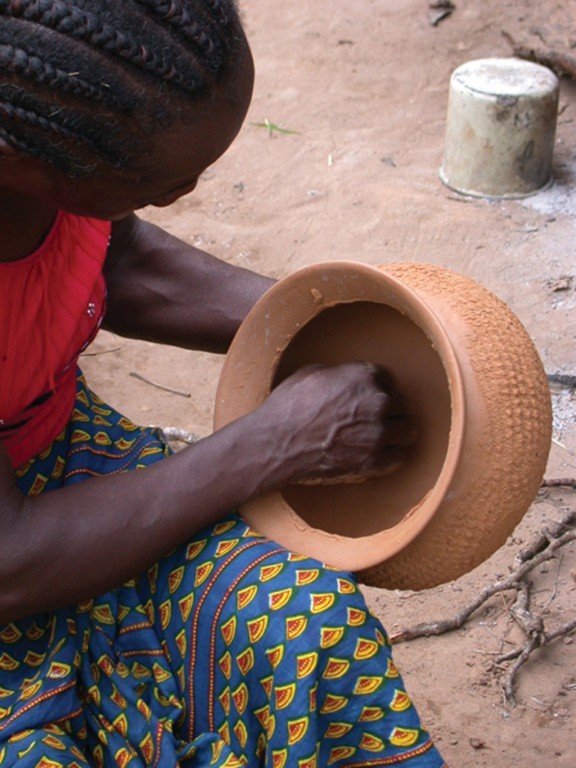First Published in

What we do know from historical records is that the culture of sub Saharan Africa, prior to the invasion of European colonisers, was quite different from that of today. Colonialism - with its imposition of foreign systems through force and coercion had a decided effect on the development of indigenous creative design solutions.
Which begs the question: "If colonialism had never happened, what direction could the traditional makers of things have taken and how different might the creative language and design landscape of Africa be today?"
At the advent of the colonial period, the makers of functional objects within traditional African culture were not considered to be artists. In fact, many societies would not have understood the concept of whether a traditional object was beautiful or not. The idea of the artist was a western construct that had no place in African society. Instead, traditional makers of things were an important asset of any community and carried out roles that helped maintain the bonds that held communities together.
For example, the traditional potter was seen as a special individual involved in the act of "transformation" - which took place when a soft material such as clay was transformed with the application of heat into a hard impermeable ceramic. Potters created the beer drinking pots used to communicate with the ancestors as well as the large pots that stood empty near the doorways of houses, allowing the spirit of male members of the family to escape safely from battles.
Traditional potters were mainly women, who also happened to be midwives - involved in yet another kind of magical transformation. Interestingly, in some African countries, newborn children are described as being like unfired pots as their initial skin colour is different at the moment of birth.
Like the ceramicists, mask-makers were not considered to be artists either. The African mask was never an aesthetic object. It had a functional purpose - it was a metaphysical vehicle through which the ancestors or the spirits could be contacted - and its communal importance was of far more value than it visual or "artistic" qualities.
We have, at this point, to take on the uncomfortable possibility that these things only became 'art' with the advent of colonialism. Spiritually vibrant and meaningful objects were turned into no more than visual curiosities or niceties to adorn the walls of western homes, thus interfering with Africa's vibrant cultural development process. By not understanding the real importance of these objects, the western world reduced their value. Reducing the value of these objects also fitted well with the colonial political necessity of reducing the value of its subjects.
The implication is that the existence of "art" in Africa could be interpreted as being part of a greater colonialism of the mind which continues today. The definition of an object as art plays exactly into the hands of the western world. It places Africa's objects within the western creative realm. It takes away "your" - namely, Africa's - ownership and gives it to "us".
We must therefore return to our question. What would indigenous product be like in Africa if colonialism had never happened? If colonialism had not interrupted the unique creative development of Africa, what would be the outcome today? Although it is difficult to say without reservation what the direction may have been, it is possible to consider what emotional and financial benefits Africa could have gained by an uninterrupted creative development process.
One thing we can be sure of is that there would have been ownership over the creative process. Many of the countries that are at present low-cost producers of goods designed in the west for western markets would possibly have developed their own unique and indigenous solutions to design problems. Solutions that came from their own historical creative vocabulary, based in turn on their own culture.
Another outcome of this may also have been a stronger confidence in cultural tradition. Unfortunately during my work and life in Africa over the past 25 years I have seen many examples of how undervalued many aspects of traditional culture have become. In some respects the potential of this cultural creativity has not been realised, except as a means of entertaining foreign tourists, or in the creation of low-cost objects for sale in many of the craft bazaars across the continent or by the roadside.
It may also have resulted in the better recording of disappearing cultural traditions, traditions that could have been of some as yet unknown economic value in the Africa of the future. An analogy can be drawn here with the continuing destruction of the rain forests of South America. With each tree that falls another opportunity to learn and grow evaporates.
If we are able to leap in imagination at this point, we could begin to ask ourselves some very exciting questions, which could result in some totally innovative and indigenous creative directions. For example, if traditional views about communication were used by Africa's contemporary designers, then what would their telephones look like?
What I am not proposing is that everything that has been absorbed from the west since colonial times be forgotten or unlearned. Or that it is in fact of no value, or that there is nothing of traditional culture present in contemporary African objects. Contemporary Africa today has very successful artists and designers and their work helps raise the profile of the continent by being very popular with world audiences.
What I am proposing is that the ancient creative traditions and roles of the makers of things be re-visited before their full meanings disappear forever. Because within these may lie something that Africa can one day claim with pride: This is something of our own, and with this we can build our own future.
About the author
After many years of helping to develop small-scale industries in Africa, designer Carl Harrison is presently involved in developing the International Design and Education Association (IDEA) based at Nottingham Trent University in the UK, where he is a lecturer. This is an association of International Design Education and Development agencies working towards sustainable design solutions of the future. Apart from forging manufacturing links for trade associations that are looking for partners in the developing world, IDEA is also involved in developing training programmes for traditional craftspeople and larger industries. Contact: carl.harrison@ntu.ac.uk.







